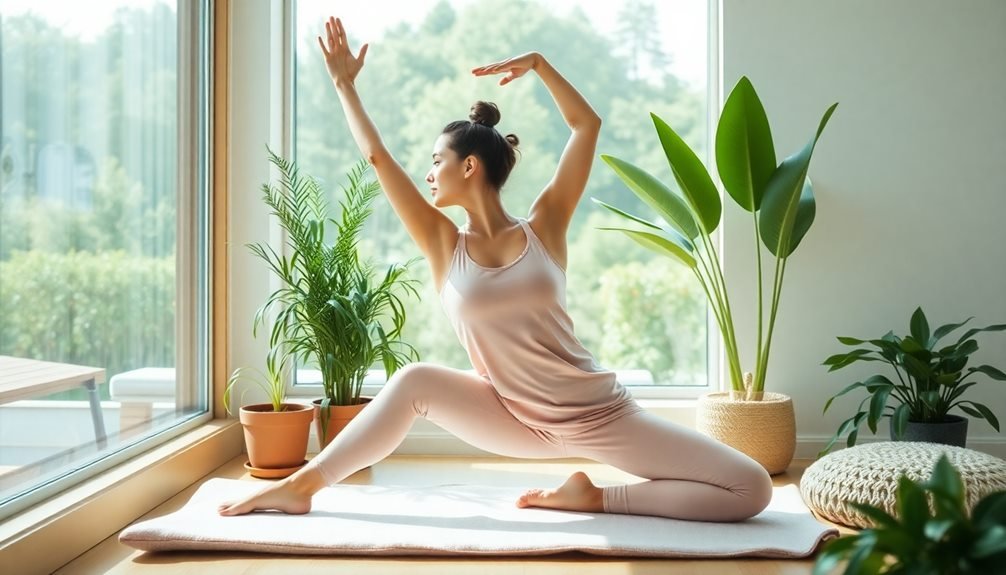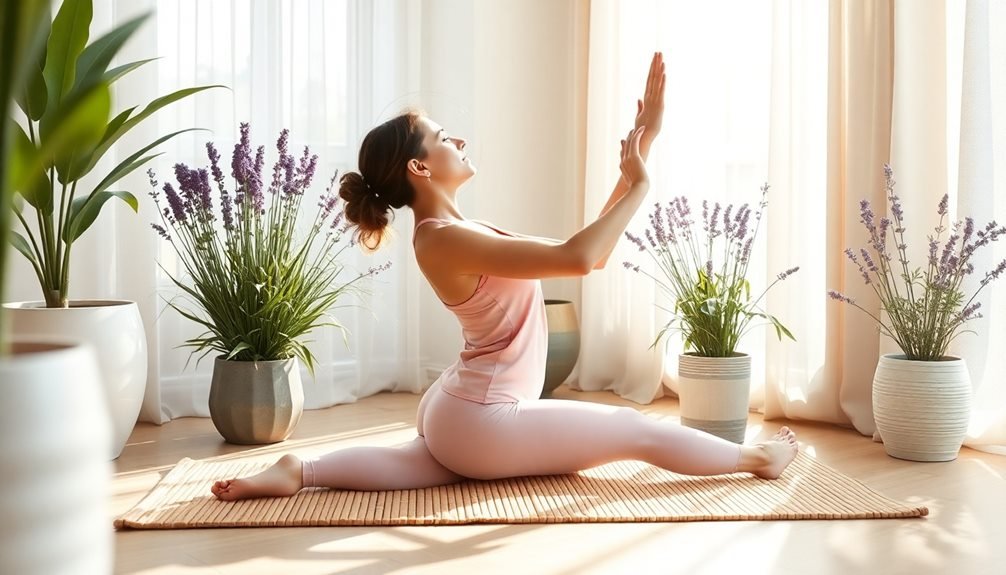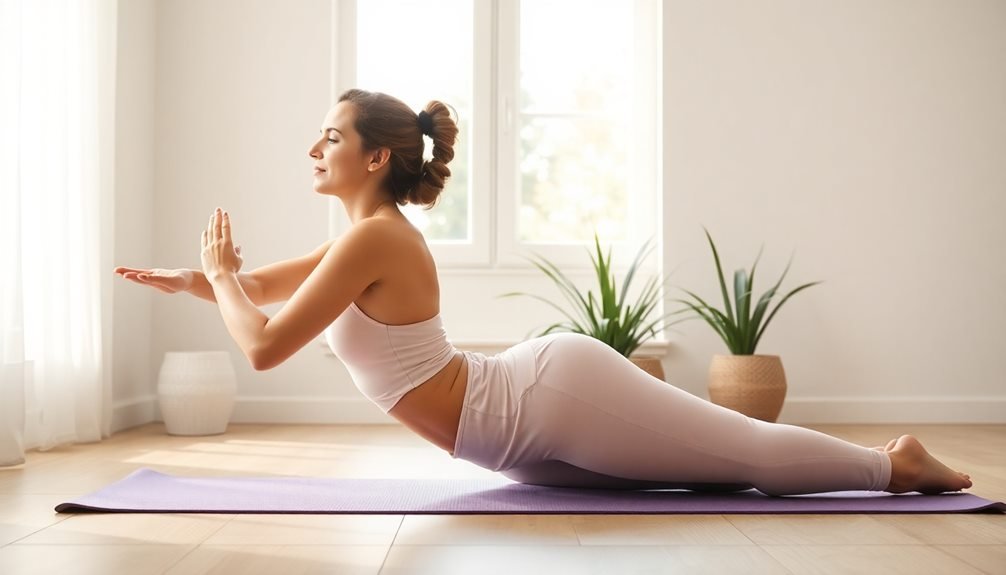Growing anxiety-reducing herbs at home gives you a double dose of calm – both from nurturing plants and using their soothing properties. Start with easy-to-grow options like lavender, chamomile, lemon balm, holy basil, rosemary, and peppermint. You'll need basic supplies including containers with drainage holes, quality potting soil, and a sunny spot that gets 4-6 hours of light daily. Beyond providing fresh herbs for teas and aromatherapy, tending to your indoor garden naturally lowers stress hormones and creates a grounding daily routine. Discover how these therapeutic plants can transform your living space into a peaceful sanctuary.
Why Grow Anxiety-Reducing Herbs

Three compelling reasons make growing anxiety-reducing herbs a smart choice for managing stress naturally.
First, you'll have immediate access to fresh, potent herbs whenever anxiety strikes, eliminating the need to rush to the store or wait for online deliveries. Whether you need a calming cup of chamomile tea before bed or fresh lavender to crush and inhale, your herbs will be ready at a moment's notice.
Second, tending to herbs serves as a therapeutic activity itself. The act of gardening reduces cortisol levels, improves mood, and provides a mindful escape from daily stressors. You'll find that nurturing these plants creates a rewarding routine that helps ground you during anxious moments.
Third, growing your own herbs guarantees you're getting the purest, most sustainable form of anxiety relief. You'll know exactly how your plants were grown, avoiding concerns about pesticides or questionable sourcing.
Plus, you'll save money in the long run by not purchasing pre-packaged herbs or supplements. With just a few pots, some quality soil, and basic gardening knowledge, you can create your own natural anxiety management system right at home.
Creating Your Indoor Herb Garden
Starting your indoor anxiety-relief herb garden requires basic supplies including well-draining containers, organic potting soil, and quality herb seedlings or seeds.
You'll need to place your herbs where they can receive 4-6 hours of sunlight daily, typically near south or west-facing windows.
If natural light is limited in your space, you can supplement with grow lights to guarantee your herbs thrive year-round.
Essential Supplies Needed
Prior to beginning your anxiety-busting herb garden, you'll need several basic supplies to guarantee success. Start with high-quality potting soil specifically formulated for herbs, ensuring proper drainage and nutrient content.
Select containers that are at least 6 inches deep with drainage holes, choosing either clay, plastic, or ceramic pots based on your preferences and budget.
You'll need basic gardening tools including a small trowel, pruning shears, and a watering can with a gentle spray nozzle. Consider adding a spray bottle for misting humidity-loving herbs and plant markers to identify different species.
Purchase a water-soluble organic fertilizer designed for herbs, as these plants require regular feeding during their growing season.
For peak growth, invest in a grow light system if your space lacks adequate natural sunlight. Choose full-spectrum LED lights that can be adjusted in height as your plants grow. Don't forget a timer to regulate light exposure.
Best Growing Locations Indoors
Inside your home, selecting the right location for your anxiety-busting herb garden plays an essential role in its success. You'll want to focus on spots that provide adequate light, proper air circulation, and easy access for daily care and harvesting.
| Location | Growing Conditions |
|---|---|
| South-facing windowsill | 6-8 hours direct sunlight, warm temperatures |
| East-facing window | Morning sun, protection from harsh afternoon rays |
| Kitchen counter | Good for supplemental grow lights, easy access |
| Home office desk | Moderate light, stress-relieving visibility |
| Bathroom shelf | High humidity for moisture-loving herbs |
Consider placing lavender and chamomile in south-facing windows where they'll receive maximum sunlight. Your kitchen counter works well for basil and mint, especially if you've installed grow lights above. East-facing windows provide excellent conditions for lemon balm and holy basil, which prefer gentle morning light.
Don't place herbs near heating vents or air conditioning units, as they'll dry out quickly. If you're working with limited natural light, you can successfully grow most anxiety-reducing herbs under full-spectrum LED grow lights, positioning them 6-12 inches above the plants for ideal growth.
Essential Tools and Supplies

Gathering the right tools and supplies sets you up for success when working with anxiety-relieving herbs. You'll need several essential items to start your indoor herb garden: containers with proper drainage holes, high-quality potting soil specifically formulated for herbs, and a water-soluble organic fertilizer.
Don't forget a watering can with a gentle spray nozzle and a moisture meter to prevent overwatering.
For plant maintenance, invest in sharp pruning shears, small garden scissors, and plant markers to identify different herbs. You'll also need a spray bottle for misting and pest control, plus natural insecticidal soap to manage any unwanted visitors.
Consider purchasing a basic pH testing kit to monitor soil conditions.
If you're starting from seeds, add seed trays, dome covers, and a heat mat to your list.
For harvesting and processing, gather clean glass jars, paper bags for drying, and a mortar and pestle for grinding dried herbs. A small kitchen scale helps measure precise amounts for herbal preparations, while mesh strainers and cheesecloth are essential for making teas and tinctures.
Stock up on amber glass bottles to store your herbal creations properly.
Best Locations for Herb Growing
When growing anxiety-reducing herbs indoors, you'll need to place them where they can receive 4-6 hours of direct sunlight daily or provide supplemental grow lights for ideal growth.
If you're planning an outdoor herb garden, choose a spot that offers well-draining soil and protection from harsh winds while ensuring adequate sunlight exposure.
Your herbs can thrive in various spaces, from sunny windowsills and balconies to dedicated garden beds or containers on your patio.
Indoor Light Requirements
Successful indoor herb growing depends primarily on proper light exposure. Most anxiety-reducing herbs need 6-8 hours of direct sunlight daily to thrive.
You'll want to place your herbs near south-facing windows, which provide the most consistent light throughout the day. If you don't have ideal window placement, consider using grow lights to supplement natural light.
Different herbs have varying light requirements. Chamomile and lemon balm prefer full sun but can tolerate partial shade, while lavender demands maximum sunlight exposure.
Holy basil and mint are more forgiving and can grow well in bright, indirect light. You'll know your herbs aren't getting enough light if they become leggy, with long stems and fewer leaves.
To maximize light exposure, rotate your pots weekly, ensuring all sides receive equal light distribution.
Keep your herbs' foliage from touching cold window panes in winter, as this can damage the plants. If using grow lights, position them 6-12 inches above your plants and run them for 14-16 hours daily.
LED grow lights work well and won't greatly impact your energy bill.
Outdoor Garden Spaces
Since anxiety-reducing herbs flourish in natural environments, your outdoor garden space should provide prime growing conditions with proper sun exposure and good air circulation.
Choose a location that receives at least 6 hours of direct sunlight daily, as most medicinal herbs thrive in full sun. South-facing areas typically offer superior light conditions throughout the day.
Consider creating raised beds or dedicated herb sections in your existing garden, keeping anxiety-reducing herbs like lavender, chamomile, and lemon balm grouped together for easier maintenance.
You'll want well-draining soil and enough space between plants to prevent overcrowding. If you're dealing with limited ground space, try vertical gardening using wall-mounted planters or tiered stands.
Protection from strong winds is essential, so position your herb garden near a fence, wall, or hedge that blocks harsh gusts while still allowing airflow.
Don't forget to factor in accessibility – you'll want to reach your herbs easily for regular harvesting and maintenance. If you live in an apartment, your balcony or patio can work well, provided it gets adequate sunlight and you use containers with drainage holes.
Calming Lavender Care Guide

Growing lavender at home requires well-draining soil and plenty of sunlight for ideal results.
You'll need to plant your lavender in a location that receives 6-8 hours of direct sunlight daily and has soil with a pH between 6.7 and 7.3. Mix sand or gravel into your potting soil to improve drainage, as lavender roots will rot in waterlogged conditions.
Water your lavender sparingly once established, as it's drought-tolerant and prefers dry conditions. You'll know it's time to water when the top inch of soil feels completely dry.
Prune your plants in early spring before new growth appears, cutting back about one-third of the plant to maintain its shape and promote bushier growth.
To harvest lavender for anxiety-relieving benefits, cut the stems just before the flowers fully open. This timing guarantees the highest concentration of essential oils.
Bundle 15-20 stems together and hang them upside down in a dark, well-ventilated area to dry. Once dried, you can use the flowers in sachets, teas, or aromatherapy applications.
Your lavender plants should last 5-10 years with proper care.
Growing Chamomile at Home
Planting chamomile in your garden offers a reliable source of this calming herb while requiring minimal maintenance. You can choose between Roman chamomile, a perennial ground cover, or German chamomile, an annual variety that grows taller and produces more flowers.
Start your chamomile indoors 6-8 weeks before the last frost date. Sow seeds directly on the soil surface, as they need light to germinate. Keep the soil consistently moist until germination occurs in 7-14 days.
Once seedlings reach 4 inches tall, transplant them outdoors in well-draining soil. Choose a spot that receives full sun to partial shade and space plants 6-8 inches apart. Chamomile thrives in average soil and doesn't need frequent fertilizing. Water moderately, allowing the soil to dry slightly between waterings.
Harvest the flowers when they're fully open by pinching them off at the stem. You'll know they're ready when the petals are horizontal and the center is domed.
Dry the flowers on screens in a warm, dark place, then store them in an airtight container for up to a year.
Lemon Balm Growing Tips

Lemon balm thrives in partial shade to full sun and needs well-draining, fertile soil with a pH between 6.0 and 7.0.
You'll get the best results growing this perennial herb in containers with drainage holes, using a quality potting mix and ensuring the plant doesn't spread aggressively into your garden.
You can encourage bushier growth by pruning your lemon balm regularly, harvesting the leaves just before flowering when their essential oils are most concentrated.
Sunlight and Soil Needs
Successfully cultivating lemon balm requires the right balance of sunlight and soil conditions. This adaptable herb thrives in partial to full sun, though it'll do best with 4-6 hours of direct sunlight daily in most climates. In particularly hot regions, you'll want to provide afternoon shade to prevent leaf scorching.
Your soil needs to be well-draining and rich in organic matter, with a pH between 6.0 and 7.0. Before planting, work compost into your garden bed to improve soil structure and fertility. While lemon balm isn't particularly fussy about soil type, it won't tolerate waterlogged conditions, so guarantee proper drainage to prevent root rot.
If you're growing in containers, use a high-quality potting mix that contains perlite or sand for drainage. Your container must have adequate drainage holes, and you'll need to check soil moisture more frequently than in-ground plants.
Don't let the soil dry out completely between waterings, but avoid keeping it consistently wet. A layer of mulch around your plants will help maintain consistent soil moisture and suppress weeds, though be careful not to pile it against the stems.
Container Gardening Basics
Container gardens offer a perfect way to grow lemon balm, even if you're short on outdoor space. You'll need a pot that's at least 12 inches deep and wide with adequate drainage holes to prevent root rot. Fill your container with well-draining potting soil mixed with organic compost for prime nutrition.
Choose a container location that receives partial sun to partial shade, as lemon balm can tolerate various light conditions. If you're growing indoors, place the pot near a south or east-facing window.
Don't let the soil dry out completely between waterings, but avoid overwatering – stick your finger about an inch into the soil, and water when it feels dry at that depth.
You'll need to prune your lemon balm regularly to maintain its bushy shape and prevent it from becoming leggy. Pinch off the top growth every few weeks during the growing season.
When the plant reaches about 8 inches tall, harvest the leaves regularly to encourage new growth. To prevent self-seeding and maintain control over your plant's size, remove flower stems as they appear. This also helps direct energy toward leaf production.
Pruning and Harvesting Methods
Regular pruning guarantees your lemon balm stays productive and maintains an appealing shape throughout the growing season. To prune effectively, pinch off the top sets of leaves when your plant reaches 8 inches tall. This encourages bushier growth and prevents the plant from becoming leggy. Remove any yellowed or damaged leaves as soon as you spot them.
For harvesting, cut stems about 2 inches above the soil level using clean, sharp scissors. You'll get the best flavor by harvesting in the morning after the dew has dried but before the day heats up. Don't take more than 2/3 of the plant at once to assure healthy regrowth.
If you're growing lemon balm for tea or cooking, harvest leaves before the plant flowers, as this is when the essential oils are most concentrated.
You can dry lemon balm by hanging bundles upside down in a warm, dark place with good air circulation. Alternatively, freeze fresh leaves in ice cube trays with water for later use.
When fall approaches, cut the plant back to about 2 inches above the ground to prepare it for winter dormancy.
Holy Basil Cultivation Methods
Growing holy basil (Ocimum sanctum) begins with well-draining soil and 6-8 hours of daily sunlight. You'll want to maintain soil temperatures between 70-85°F for ideal germination, which typically occurs within 5-10 days. Space your plants 12-18 inches apart to allow proper air circulation and root development.
For successful holy basil cultivation, follow these essential care steps:
- Water consistently but moderately, keeping soil moist but never waterlogged – check the top inch of soil and water only when it feels dry.
- Feed plants monthly with balanced organic fertilizer (5-5-5) during the growing season, reducing to every six weeks during winter months.
- Pinch off flower buds as they appear to encourage bushier growth and prevent the leaves from becoming bitter.
- Monitor humidity levels and maintain 40-60% by misting or using a pebble tray, especially if growing indoors.
You can start seeds indoors 6-8 weeks before the last frost date or direct sow when soil temperatures reach 70°F. The plants don't tolerate cold, so bring them inside when temperatures drop below 50°F.
Regular harvesting encourages continual growth throughout the season.
Rosemary Care and Maintenance

With proper attention to basic needs, rosemary (Rosmarinus officinalis) thrives as a low-maintenance herb that can live for decades.
You'll need to provide well-draining soil, full sun exposure, and moderate watering to keep your rosemary healthy. Plant it in containers with drainage holes or directly in garden beds where water won't pool around its roots.
Water your rosemary only when the top inch of soil feels dry, as overwatering can lead to root rot. During winter, reduce watering frequency and guarantee good air circulation to prevent fungal issues.
You'll want to maintain temperatures above 30°F (-1°C), as rosemary isn't frost-hardy in most regions.
Prune your rosemary regularly to maintain its shape and promote bushier growth. Don't remove more than one-third of the plant at once, and always use clean, sharp pruning shears.
Fertilize sparingly – once in spring and once in summer with a balanced, all-purpose fertilizer is sufficient.
If you're growing rosemary indoors, place it near a south-facing window and use a humidity tray during heating season.
Rotate the container weekly to guarantee even growth, and repot every two to three years when roots become crowded.
Peppermint Growing Basics
Moving from rosemary's Mediterranean nature, peppermint offers a different but equally rewarding growing experience. This hardy perennial thrives in partial shade to full sun and prefers rich, moist soil with good drainage.
You'll find that peppermint's vigorous growing habit means it's best contained in pots or bordered areas to prevent it from spreading throughout your garden.
To successfully grow peppermint at home, follow these key guidelines:
- Plant in containers at least 12 inches deep, using organic potting mix enriched with compost.
- Water regularly to keep soil consistently moist but not waterlogged – check moisture levels twice weekly.
- Harvest leaves before flowering for the strongest flavor, pinching stems back to encourage bushier growth.
- Divide plants every 2-3 years to maintain vigor and prevent overcrowding.
You'll know your peppermint is healthy when it displays dark green leaves and strong, upright stems.
If you're growing indoors, place your containers near a window that receives 4-6 hours of filtered sunlight daily.
Remember to trim your plant regularly, as this promotes fresh growth and prevents legginess.
Harvesting and Drying Methods

Success in preserving your anxiety-busting herbs depends on proper harvesting and drying techniques.
You'll want to harvest your herbs in the morning after the dew has dried but before the day's heat sets in. Cut healthy stems using clean, sharp scissors, leaving at least 6 inches of growth on the plant to guarantee continuous production.
Before drying, gently shake the stems to remove any insects and debris. Don't wash the herbs unless they're visibly dirty, as excess moisture can lead to mold. If washing is necessary, pat them completely dry with paper towels.
You can dry herbs using several methods: air-drying, dehydrating, or oven-drying.
For air-drying, bundle 4-6 stems together with twine and hang them upside down in a warm, dark, well-ventilated area.
If you're using a dehydrator, arrange the herbs in a single layer and dry at 95°F for 2-6 hours.
For oven-drying, spread herbs on a baking sheet and dry at the lowest temperature setting with the door slightly open. Your herbs are ready when they're crispy and crumble easily.
Store them in airtight containers away from direct sunlight.
Making Your Own Herbal Tea
Once you've properly dried your anxiety-busting herbs, making tea becomes a simple and rewarding next step. Using dried chamomile, lavender, lemon balm, or passionflower, you'll create calming blends that support your emotional well-being.
Start with a clean, heat-safe container and consider using a tea infuser or disposable tea bags for convenience.
For the perfect anxiety-reducing cup, follow these essential steps:
- Measure 1-2 teaspoons of dried herbs per 8 ounces of water, adjusting the amount based on your taste preferences and the herb's potency.
- Heat fresh, filtered water to just below boiling (around 190°F) to preserve the herbs' delicate compounds.
- Pour the hot water over your herbs and cover the container to trap the beneficial oils and aromatics.
- Steep for 5-10 minutes, depending on your desired strength and the specific herbs used.
You can create custom blends by combining different anxiety-reducing herbs. Try mixing chamomile with lavender for sleep support, or lemon balm with passionflower for daytime stress relief.
Store your leftover dried herbs in airtight containers away from direct sunlight to maintain their potency.
Natural Aromatherapy Room Sprays

Transform your living space into a calming sanctuary with natural aromatherapy room sprays made from anxiety-reducing herbs.
You'll need a spray bottle, distilled water, witch hazel, and essential oils derived from your home-grown herbs. Lavender, chamomile, and lemon balm make excellent choices for their soothing properties.
To create your spray, combine 1/2 cup of distilled water with 1/4 cup of witch hazel in your bottle. Add 15-20 drops of essential oils – try 8 drops of lavender, 6 drops of chamomile, and 4 drops of lemon balm for a balanced blend.
Shake well before each use, as the oils will naturally separate from the water.
Spray your natural aromatherapy blend in bedrooms, living areas, or home offices. You can also mist your pillowcases before bedtime or spritz your yoga mat before practice.
For maximum effectiveness, create different blends for various purposes – a more energizing spray with rosemary and mint for your workspace, or a sleep-promoting blend with extra lavender for your bedroom.
Store your sprays in dark glass bottles away from direct sunlight to preserve their therapeutic properties.
Frequently Asked Questions
Can Anxiety-Reducing Herbs Interact Negatively With Prescription Medications?
Yes, anxiety-reducing herbs can interact with your prescription medications. You'll need to talk with your doctor or pharmacist before using any herbal remedies to make sure they're safe with your current meds.
How Long Do Dried Anxiety-Reducing Herbs Remain Potent and Effective?
You'll find most dried anxiety-reducing herbs stay potent for 6-12 months when stored properly in airtight containers away from light and heat. They'll start losing their therapeutic properties after that time period.
Are These Herbs Safe for Pets Who Might Nibble Them?
You'll need to be careful, as some herbs can harm your pets. Common herbs like lavender and chamomile are generally safe, but you should keep cats away from valerian. Always check with your vet first.
Can Anxiety-Reducing Herbs Lose Their Calming Properties if Grown Indoors?
You won't lose anxiety-reducing properties when growing herbs indoors. As long as you provide proper light, water, and nutrients, your indoor herbs will maintain their calming compounds just like their outdoor counterparts.
What Time of Day Is Best to Consume Herbal Tea for Anxiety?
You'll get the most benefits from anxiety-relieving herbal teas in the morning or early evening. Start your day with an uplifting cup, or wind down before bed – just avoid drinking too close to bedtime.
In Summary
Growing your own anxiety-reducing herbs lets you create a peaceful sanctuary while nurturing plants that'll calm your mind and body. You'll save money, enjoy fresh herbs year-round, and know exactly what's going into your teas and aromatherapy products. Start small with just one or two plants, and you'll soon discover the therapeutic benefits of tending to these natural stress-busters in your home oasis.





Leave a Reply